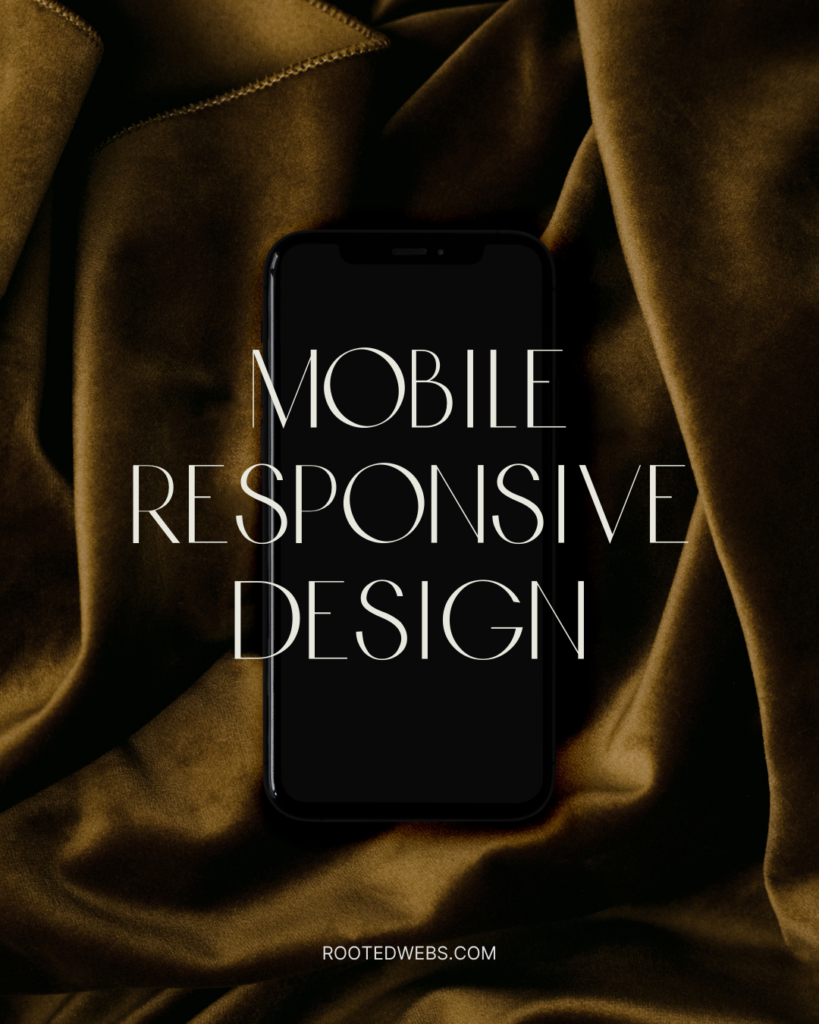type below and hit enter
Search the blog
This little corner of the internet is where I pour out the lessons and insights I've gathered on my journey, all with the intention of lighting your path as you navigate the exciting world of business. And hey, while you're here, don't miss out on your complimentary website audit – it's on the house! Let's make your online presence shine together.
I'm glad you're here
Mobile Responsive Design Strategies
January 3, 2021

What is mobile responsive web design?
Responsive web design is essential to the user experience. Studies have shown, if a website is too hard to navigate via smart devices, consumers are more likely to leave a site and try something else. Optimizing your site or mobile design helps keep people on your site, improves online presence, and increases conversions.
Let’s say you and your family spend an afternoon in the park with your grandparents. After walking some trails, you decide to grab lunch as a group. But what’s close? What’s open? Can you dine-in, or are they doing carry-out only due to COVID-19? Alas, you find a cute Italian restaurant that’s open for dine-in seating. Suddenly your parent brain kicks in and you decide to check and see if they have a kid’s menu. You click the website tab on the Google page and attempt to browse around the website. It loads slow, is disproportionate in size, the menu layout is weird, and now you wonder if they’re even open. This is an example of unresponsive web design.
Mobile browsing continues to grow and is now the leading way people access most websites. In 2016, researchers found that just over 60% of people who access a website do so on a mobile device. Gone are the days of designing a one size website. With society’s integration and somewhat reliance on smart devices like phones and tablets, it is becoming more important than ever to ensure that a website is easily adaptable on different sized screens. This article will detail some strategies for designing a website to be mobile responsive.
What is mobile responsive web design?
Successful web design meets users where they are. Whether viewed on a phone, computer, or tablet, a successful website is accessible and user friendly no matter what. Responsive design refers to the methodology of designing multiple versions of a website for optimal viewing on desktop monitors as well as mobile devices. In a nutshell, responsive web design adapts a website to the size of the screen of which it is being viewed.
Responsive Design vs Mobile First
Now that we’ve defined responsive design, There are several approaches to mobile responsive design strategy. If you’ve been in business for a long time, your original website may have come before the rise in tablets and smartphones. In this instance, adaptation, or changing the coding of the site to make it “responsive” would be necessary. For others, who may be creating a website for the first time, the website may be mobile, or “mobile-first” initially depending on your goals and audience. In the design field, there’s been plenty of debate about which is better, but the truth is, you still need both.
Different Mobile Design Strategies

Content Strategy
No matter the size platform you’re designing for, making the site user friendly is a top priority. Always think about your messaging and purpose first. Content strategy is at the forefront of responsive design. Consider the kind of content you’re displaying and how it is best optimized on different screen sizes. It’s a good practice to focus on the order of importance and what actions you want viewers to take.
Responsive Navigation Is Key
Navigation is a large component of UX and UI. According to a research study performed by Nielson Norman Group, mobile users are more likely to use the navigation menu than desktop users. This phenomenon can be attributed to two things, the first being that developers often overlook the navigational needs of desktop design. The second being that with less space to utilize, mobile users are forced to use the navigation to find information. Either way, if we know that users quickly leave sites that aren’t functional, it’s smart to invest some thought into what mobile navigation looks like.
There have been discussions over the best methods of presenting menus on mobile sites. The hamburger or three-line style menu tends to be the most popular. Whether you decide to place your navigational tools at the top, bottom or chose to have it move with the top of the page, navigation is something that should be thought out carefully and included in responsive design strategies.
Avoid Porting For Best Results
It’s not that porting is lazy, it just leaves too much to chance. For those unfamiliar, porting is basically using the same code across all devices and praying for the best. in terms of UI. Historically, it never works. Do you remember when smartphones first came out and how horrible most websites looked on a mobile device – yep, that was a symptom of porting. It may take a little time, but implement a multi-platform design strategy. Your customers will thank you.
There are so many different sized devices out there. Obviously, you don’t want to make a new design for every size device, but you’ll still want to incorporate some variety. Some designers suggest playing it safe with at least three different sized designs geared towards the desktop, average tablet size, and average phone size. This is a smart place to start.
SEO
Somehow it always comes back to SEO. Here’s the thing SEO and responsive design are directly linked. Search engines, specifically Google, now seek responsive websites first. It makes total sense as the majority of users prefer browsing the internet on their smartphones. On July 1, 2020, Google announced it would give preference to mobile-first designs. Sadly, too many businesses still have not gotten with the times and updated. Responsive design
Responsive Design Principles
It is not always necessary to redesign your whole website, but like web design in general, mobile design strategies have some ground rules. The basic designed principles should be observed – simple colors, easy to read fonts, etc. It is better to embed videos vs uploading. Keep file sizes small. Keep contact information and call to actions easily accessible.
Consider how the layout should and will change. For example, if your site features two columns, the responsive design could be simplified to one column. Less is almost always more, and if your desktop design is intricate, consider simplifying the mobile design.
To conclude, audit your website and assess how user friendly it is on mobile platforms. Ensuring that your website is mobile user friendly should be a top priority. UX affects bounce rates, share-ability, and conversions. Don’t be the guy that overlooks it. And remember you don’t have to create a brand new site, nor do your designs have to be 100% identical. They just need to be accessible.
This little corner of the internet is where I pour out the lessons and insights I've gathered on my journey, all with the intention of lighting your path as you navigate the exciting world of business. And hey, while you're here, don't miss out on your complimentary website audit – it's on the house! Let's make your online presence shine together.
I'm so glad you're here
Hello There!
© 2020 - 2025 Rooted Webs, LLC (DBA Rianne Nycole Designs). all rights reserved.